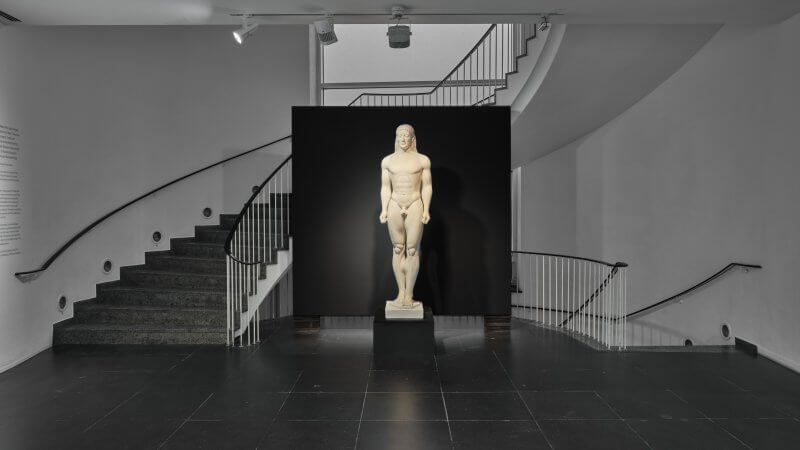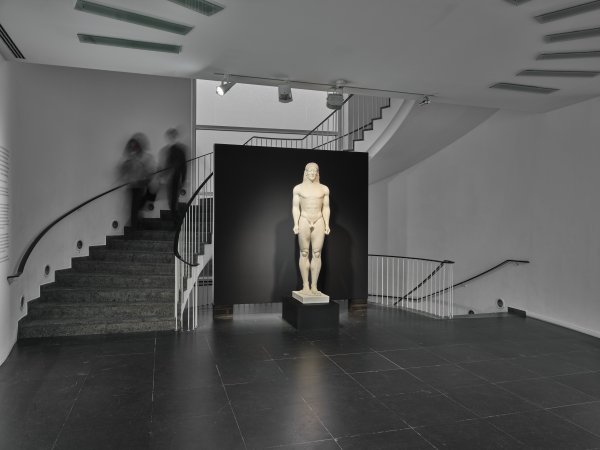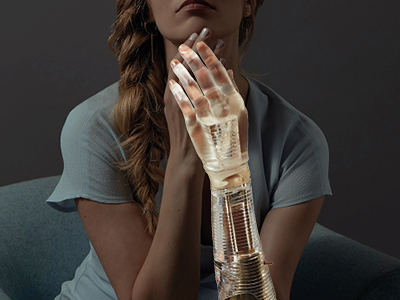Collection of Classical Antiquities and Sculpture Hall of the Goethe University Frankfurt
Kroisos-Kouros (Copy of the Kroisos Kouros, original dated to around 530 BC.)
Plaster, painted, with integral base
56 x 60 x 210 cm
Courtesy Collection of Classical Antiquities and Sculpture Hall of the Goethe University Frankfurt
The kouros represents the archetype of an artistic form, a type of statue in which the human body becomes an expression of cosmic order, social identity and shared values. This form of free-standing sculpture emerged between the 7th and 5th centuries BC and was displayed in public spaces during the Archaic period of Greece. In Ancient Greek, ‘kouros’ means ‘youth’ or ‘young man’. Its female counterpart is the ‘kore’.
In the exhibition Anatomy of Fragility, the Kroisos Kouros statue marks the beginning of a journey into the world of the human body’s image. It is a plaster replica from the Collection of Classical Antiquities and Sculpture Hall of the Goethe University Frankfurt. This specific representation is also known as Kouros of Anavyssos, and the original is housed in the National Archaeological Museum in Athens. Slightly differing variants of this basic type were found throughout Greece and rediscovered in later periods.
We see an upright male figure, welcoming visitors as they enter the foyer of the Frankfurter Kunstverein. The left foot is set slightly forwards, and the legs are firmly planted, yet suggest movement, as if the body were about to take a step. The long hair is braided, and the arms hang calmly at the sides, but the clenched fists convey a sense of energy and readiness for action. The body is youthful, symmetrical and powerful, with muscles clearly defined.
And yet, it is not a naturalistic depiction. The sculpture reflects, on the one hand, the attempt to depict the human body with anatomical accuracy through close observation, and on the other hand, it adheres to strict stylistic conventions such as proportional grids, axes of symmetry and abstracted forms. The figure embodies an ideal type. It represents less an individual body than a culturally codified and regulated idea of a ‘beautiful body’. The image becomes a sign and a symbol in which a society mirrors itself. In Greek society, the free, adult man was the measure of all things. He embodied kaloi kagathoi—the beautiful and the good—as noted by cultural historian Mireille M. Lee.
Accordingly, the male body was regarded as the standard and ideal figure, as bearer and expression of a collective self-image.
The term ‘kouros’ (plural: kouroi) defines a fixed visual schema, a representation that developed from Egyptian models of monumental sculpture. In the kouros, one can see how the depiction of the body changed in comparison with its Egyptian predecessors. The uneven distribution of weight, the emphasis on the joints and the knees convey movement, dynamism, vitality and physical presence. The kouros thus became an expression of a new engagement with anatomy, proportion, bodily tension and statics in Archaic Greek sculpture.
More than 600 of these marble figures have survived, including numerous female statues, the so-called ‘korai’ (singular: kore). The male and female body images reflect the ideals of Archaic elite society—a time when the polis emerged as the dominant form of community and warfare shaped social life. For the patrons of these figures, who belonged to the social elite, the ideal archetype of the human being lay in the unity of physical beauty and moral virtue. They sought idealised statues of young men and women that would express both external appearance and inner greatness.
A central feature of all kouroi and korai is the so-called ‘Archaic smile’. It expresses self-control, dignity, decency and inner order—values that shaped the conduct and bearing of the Greek elites in the Archaic period. Among the kouroi and korai that have been found, stylistic deviations can be observed. The archaeologist Francis Prost explained these variations as conscious choices in representation, and that they expressed what distinguished a particular polis.
According to Prost, the style of the kouroi was a system of signs, a visual vocabulary through which the elite of one polis distinguished itself from that of another. The kouroi thus served as instruments of cultural self-definition. The depictions of the body corresponded, on the one hand, to ideal aesthetic conceptions; beyond this, they embodied the values and the political identity of an entire society.



